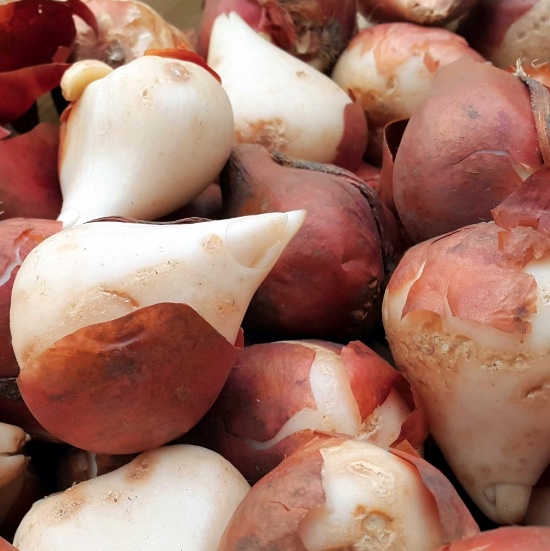Bulbs, Bulbs, Beautiful Bulbs - Work Now, Enjoy Them in the Spring

Spring flowering bulbs are the best blooming investment you can make in your garden, BUT you have to do the work NOW have beautiful blooms this spring! While you can plant bulbs into late November, get them into the ground in October or early November; water them well and their roots will grow vigorously this fall to give you better blooms next spring.
Now, what to plant? There is a huge variety of spring bulbs, different colours, different heights and most important, different bloom times. Your objective should be to use this variety to generate the longest possible period of bloom, from snowdrops in early April to alliums in June.
| EARLY |
MID SEASON |
LATE |
| Snow Drops |
Trumpet Daffodils |
Late Flowering Tulips |
| Crocus |
Hyacinth |
Lili Tulips |
| Anemone Blanda |
Mid Season Tulips |
Grape Hyacinths |
| Mini Daffodils |
Double Daffodils |
Giant Alliums |
| Early Single Tulips |
Fritillaria Imperialis |
|
When buying bulbs, as in most things in life, SIZE MATTERS. Bigger bulbs make bigger blooms. Check out the size of the bulbs that are available. Look for 12-14 cm (the circumference of the bulb) or more for daffs and pay a little more for bigger bulbs. Some online suppliers provide mixed collections of different colours that will save you money. If you order from a catalogue, get your order in fast, as some suppliers run out of the most popular kinds early in the season. Gray Heron Nurseries (formerly Ormsby’s on Hwy 26 just before Meaford) still has a wide variety of bulbs available.
Planting is easy. Select a sunny area, the more sun the better. If your garden is shady, don’t worry, plant very early bulbs which will enjoy the sun coming through the bare branches before they leaf out. Your soil should drain well, as bulbs don’t like wet feet. If you have clay soil, add 3 inches of sand or ravel to the bottom of the hole. Ideally, you should have a loose soil with lots of organic material like compost, at least for the soil used to fill up the hole over the bulbs.
Plant bulbs in concentrated groups of 7 to 11 in several spots in your garden for a real show. Otherwise you will have a spotty “meals” display with little impact. Avoid long rows of say 20 daffs. Five groups of 5 (I know it’s 25) will be more impactful. Plant a minimum of 5 to 7 bulbs in each hole, with the bulbs spaced 3 inches apart. The experts say, always plant odd numbers of bulbs 5, 7 or 9. (I’m told it’s a design thing.) Check the package for the proper depth to plant, as it varies by type of bulb.
Dig a good-sized hole to an inch below the correct depth, loosen up the soil at the bottom, add a sprinkle of “bulb food” or bone meal (formula 4 -10 – 4, make sure it’s a big middle number) and mix it in, tamp down the soil, add an inch of compost and set the bulbs in the compost. Fill up the hole with more soil/compost mix, adding a sprinkle of bone meal when the tops of the bulbs are covered by 1” of mix. For our cold winters, when the snow melts away in mid-January, it’s good to add a couple of inches of mulch over the planting hole. It will help keep the soil temperature more even. Pull it back in early spring and let the warm sun in. Reapply the mulch after blooming to deter weeds.
Now what about pesky squirrels, chipmunks and skunks? They love tulips and will dig up your tulip bulbs this fall and eat the blooms in spring. Some people recommend moth balls on the top of the soil, but don’t go as far as a pellet gun. I recommend a piece of chicken wire placed an inch below the soil over hole where the tulips are planted and then and cover it up. You can add moth balls on the top of the soil for good measure The key is, the squirrels can’t get through the chicken wire, but next spring, the tulip stems will come right through the wire and bloom.
Happy Gardening,
John Hethrington, Master Gardener, Emeritus
Past President, Master Gardeners of Ontario

 Beaver Valley Probus Club
Beaver Valley Probus Club